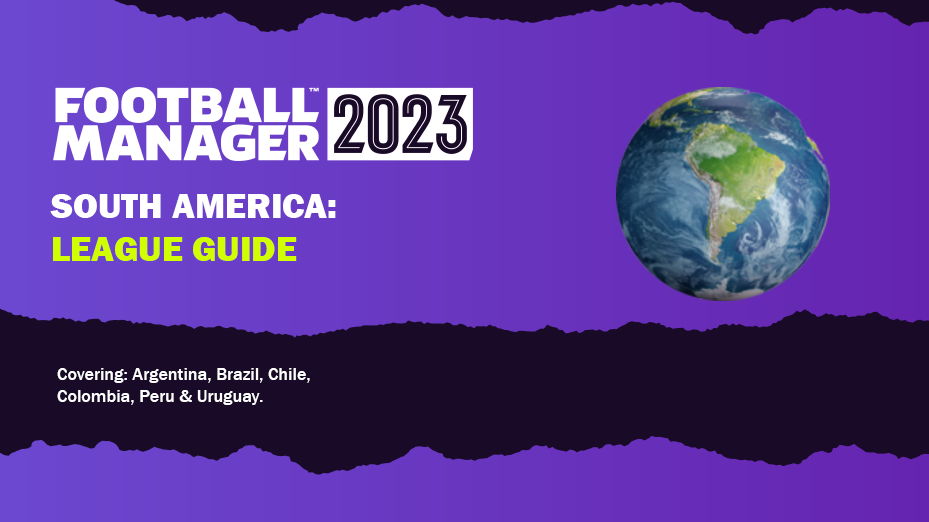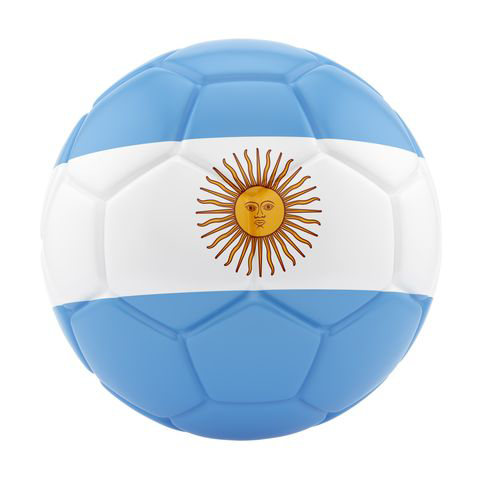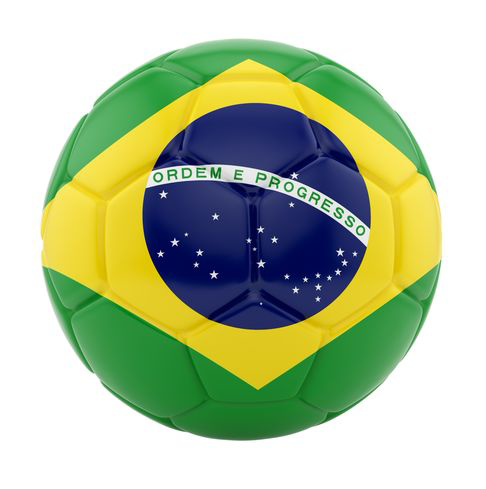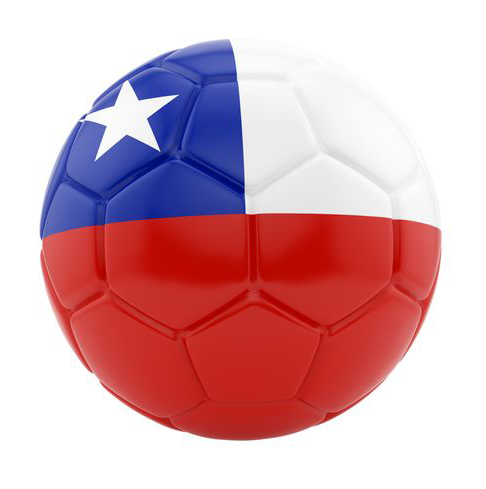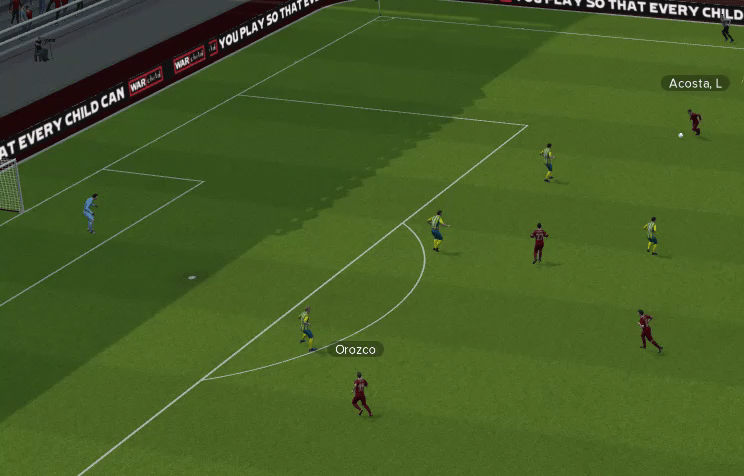Intro
Welcome back to a more streamlined version of the annual South American league guide. In previous years I have given fairly detailed commentary on the top ‘out-of-the-box’ leagues of Argentina, Brazil, Chile, Colombia, Peru & Uruguay, but this year I want to keep in concise. Instead I’ll simply present you the headline league information you need to make a decision on which one is right for you. It is also worth noting that subsequent FM23 seasons after 2022 will feel ‘more normal’ than ‘the covid years’ and November 2022 World Cup year which have caused huge upheaval in South America since FM20.
This is Part I of II, with Fernando (Rock’s End FM) returning to the blog to present you one club from each league with a more focussed case study. These recommendations are not necessarily defined as Easy-Medium-Hard as in previous years, instead they’re be ‘interesting saves’ to consider. They will be blog posts with case studies from two nations at a time.
If you like any of these posts, or think it will be useful to others, please share via the link at the bottom of this page. The aim of this post has always been to tackle the “I don't know enough about South American football, which means I won’t go there” attitude towards some of the most fun leagues in Football Manager. Even if this post helps just one person in FM23, then it’s been worthwhile.
Glossary
Opening and Closing - a South American format which sees a league season split between two halves of a calendar year, usually involving the same teams.
Average Points - An aggregation of points from current and previous seasons in order to decide matters. In South America, this is often used to decide relegation.
Argentina
At the time of writing, the 2022 Winter FIFA World Cup is almost here; and Argentina go into the tournament as an outside bet for a surprise win. But whatever happens, it will surely be Lionel Messi’s last World Cup…and then the search for a new legendary playmaker begins. Is this where you come in? Consider Argentina, it’s crazy with year-on-year changes…but most importantly: fun!
Game Start: Argentina offers start dates in 2022 (both start of calendar year or mid-way).
League Structure: February to May 2022, 28-teams begin with two groups of 14 known in FM as ‘Argentine League Cup’. Top 4 teams in each group will play two-legged QFs, SFs before the showpiece single-legged final. From July to November 2022, 28 teams play the traditional league with each side playing each other once. In-game this is called the Argentine Premier Division. Continental qualification can be achieved via winning League Cup/Premier Division/Copa Argentina and also via an aggregated table taking into account both league tournaments (subject to being properly replicated in FM23).
Relegation: Bottom 2 teams from average points table are relegated.
Useful Information: Year-on-year changes mean the number of teams in the top-tier fluctuates. Argentina will keep you on your toes until 2027 where the restructuring stops and sees players end up with a 20 team/38 game season league, in which Average Points relegation is also done away with. My advice is to consult the Overview/Rules section in the league window each year before the season starts!
Brazil
Brazil’s Serie A is a nice entrance to South America for the traditional 38-game-European football fans. However, the state championships Vs rival clubs are a unique challenge…meaning Brazil is a great place to go.
Game Start: Brazil offers start dates for each calendar year (2022 and 2023).
League Structure: April to December 2022 sees 20 teams playing each other home and away.
Relegation: Bottom 4 teams are relegated.
Useful Information: Additional regional state leagues played from January to April offer a nice side-challenge to the save, where you will play geographic rivals.
Chile
Chile is as close to the European way of accepting champions as it gets. The league leader after each team has played each other twice is the league winner. Like Brazil, it’s another bridge league for European players to try out South America with relative ease.
Game Start: Chile offers start dates for each calendar year (2022 and 2023), but you’re also offered the chance to begin mid-way into 2022 and 2023 years.
League Structure: February to October 2022 sees 16 teams play each other home and away.
Relegation: Bottom 2 teams from average points table are relegated.
Useful Information: Whilst Under-21 players are eligible to play in all matches, match day squads must contain at least two Under-21 players. Chilean Primera Division rules also state that teams have to play Under-21 players at least 70% of total minutes, or face a 6 point deduction.
Colombia
In Colombia, prepare for LOTS of games and the scheduling minefields that will ensue. In a complete parallel to Chile, you’re not a champion in Colombia until you have navigated a ‘Quadrangular’ and a subsequent Opening or Closing Final.
Game Start: Colombia offers start dates for each calendar year (2022 and 2023).
League Structure: January to June 2022 Apertura of 20 teams. Repeated again for Clausura from July to November 2022.
Relegation: Bottom 2 teams from average points table are relegated.
Useful Information: After Apertura & Clausura, the top eight teams are separated into two groups of four who will play one another twice home/away (the top 2 teams from Apertura and Clausura will be separated, but the other 6 teams are drawn into each group). The winner of each group (Quadrangular) will then play one another (again home/away) to see who is crowned league winner. This means there will be two league champions each year.
Peru
No league in World Football changes like Peru does, with their Football Association often changing competitions and schedules at relatively short notice. Peru has a traditional Opening and Closing format in FM23, for now at least…
Game Start: Peru offers start dates for each calendar year (2022 and 2023).
League Structure: February to June 2022 Apetura of 19 teams. Repeated again for Clausura from July to October 2022.
Relegation: Bottom 2 teams are relegated. Position 17th faces relegation playoff.
Useful Information: Peruvian domestic football changes annually, which means Sports Interactive has a near impossible task of predicting future seasons. The Copa Bicentenaro [a recently launched domestic cup] has now been cancelled, and is not part of the Football Association’s plans going forward.
For the first couple of seasons, points deductions are applied to teams if they cannot grant 765 minutes to sub-20 players over the 18 matches played. 3 points deducted for every 90 minutes under threshold.
For the first couple of seasons, 1st and 2nd in Peruvian Reserve league awards points to their parent club. Winner grants 2 points bonus, Runner Up grants 1 bonus point.
Uruguay
Uruguay crowns one winner each calendar year from its three domestic competitions: Opening, Intermediate and Closing formats. Technically you could win neither but still top the overall table in which all three competition points feed into, which means you’d make the Grand Final. It is a league where you need to bring your A Game when it matters…
Game Start: Uruguay offers start dates for each calendar year (2022 and 2023).
League Structure: February to May 2022 Apetura of 16 teams. Repeated again for Clausura from August to October 2022. Between the two stages, sixteen teams split into two groups of eight. The group winners play each other in a one-legged final to determine the mid-season Champion.
Relegation: Bottom 3 teams from average points table are relegated.
Useful Information: despite there being three separate tournaments, there is an overall table of which points from all three tournaments are collated. The reason is that the overall table has a say in who gets to be crowned the Uruguayan Grand Champion for that calendar year, and also decides who gets relegated.
To decide the ‘Grand Champion’: the winner of both the Apertura and Clausura play one another in a Semi Final*. The winner plays the team in 1st place of the overall table in a Grand Final. There are occurrences where either the Semi or Grand Final never happen, e.g. a Semi Final winner topping the overall table meaning no Grand Final OR a club winning both Apertura & Clausura AND heading up the overall table, meaning no Semi Final.
Continental Competitions
Can you stop Gabriel Barbosa’s Flamengo in FM23?
Whichever nation you choose to manage in, the spectacles of the CONMEBOL Libertadores and Sudamericana tournaments are offered to all. Specific details as follows:
Copa Libertadores - South America's most reputable trophy, which runs throughout the calendar year (January to November). 47 teams participate in three stages: Qualifying, Group Stage and Knockouts. Knockouts are two-legged home & away ties…until you get to the final, which is played as one tie at a neutral venue (the 2023 final will be in the Estadio Monumental Isidro Romero Carbo, Guayaquil, Ecuador).
Winning the Copa Libertadores will mean you qualify for it once again. The winner will also enter the FIFA Club World Cup & the Recopa during the next calendar year (see entry below).
Copa Sudamericana - South America's second continental competition, which also runs throughout the calendar year (March to November). 44 teams enter in at various stages, which includes a Group Stage of four teams in eight groups (32 teams) after First Round. Knockout games are two-legged home & away ties, except final which is played as one tie at a neutral venue (the 2023 final will be in the Arena BRB Mané Garrincha, Brasília, Brazil). The winner will qualify for the subsequent Copa Libertadores campaign and also enter the Recopa (see below).
Recopa Sudamericana - This is the South American Super Cup: winners of both the Libertadores and the Sudamericana face-off against one another over two legs home & away. If tied on aggregate, the away goals rule would not be used, and 30 minutes of extra time would be played. If still tied after extra time, a penalty shoot-out is used to determine the winner.
Although not as prestigious as the Copa Libertadores, clubs and fans will still place a great deal of importance on winning this trophy. In my opinion, the move towards neutral venues in both the Copa Libertadores and Sudamericana may also heighten the excitement for the annual Recopa tournaments. As it would give more fans the chance to once again see their clubs win continental honours live in their own stadium (something the Libertadores & Sudamericana have recently ditched).
I hope you found this guide useful, and you enjoy Football Manager 2023 on the South American continent!
Tony / FM Grasshopper

